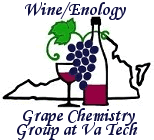 Enology
Notes #64, November 20, 2002
Enology
Notes #64, November 20, 2002
To: Regional Wine Producers
From: Bruce Zoecklein, Head, Enology-Grape Chemistry Group, Virginia Tech
Subject: Aroma/Flavor and the 2002 Season, continued; Enology Advisory Committee Formed ; Virginia Winegrowers Advisory Board Progress Reports On-line.
Aroma/Flavor and the 2002 Season, continued. As discussed in the previous edition, temperature is a primary influence of macro-, meso- and micro-climate. Seasonal temperature variations have a strong influence on aroma/flavor compounds, as do trellis system and canopy management. Because canopy climate is influenced by the grower, this is particularly important in influencing wine style.
Row direction will influence sunlight interception. Because of the effect on fruit chemistry, row orientation is a critical feature in establishing a new planting. This relationship depends, in part, on cloudiness and latitude.
Vineyards at 35 latitude in mid-summer can show a significant difference (up to 17%) in sunlight interception between north-south vs. east-west rows; the north-south rows show greater sunlight and heat interception. South-facing slopes intercept more sunlight, and are preferred in cool growing regions. This may be quite different from what is optimum for warm regions, depending on the cultivar.
The difference in sunlight interception occurs based on vine side. I have previously reported significant differences in fruit chemistry (including glycosides and phenol polymerization) as a function of the side of the grapevine canopy with Virginia Cabernet Sauvignon
Fruit on the south side of an east-west oriented row will receive more sunlight than on the northern side. We have noted that such fruit generally ripens at a faster rate. As discussed in the previous edition, we have seen a trend which suggests that earlier ripening may be a positive quality attribute.
The issues for established vineyards are Is there a difference in light interception based on side of the canopy? How should these differences be managed to maximize wine quality?
We are making significant advances with regard to the relationships between vineyard management and wine quality.
For example, a California colleague has searched the hundreds of distinct chemical compounds that make up fermented grape juice, including tannins, phenols, anthocyanins, terpenes, norisoprenoids, etc.
He has identified 84, 32 in reds and 52 in whites, as those most responsible for desirable sensory features. In different proportions, these make one wine perceived to be worth $100 and another only $10. We hope to take such information and determine the impact of vineyard management on there compounds.
Enology Advisory Committee Formed. The Department of Food Science and Technology and College of Agriculture and Life Sciences at Virginia Tech have appointed an Enology Advisory Committee. The goal of this group will be a comprehensive review of the research and extension programs of the Enology-Grape Chemistry Group. It is hoped that this committee will help establish short- and long-term goals, and methods of monitoring those goals.
With current budget reductions of 20% at Virginia Tech and more cuts expected after the first of the year, it will be more essential than ever that we work to maximize our diminished resources. The five member Enology Advisory Committee consists of:
Steve Haskill
Ph.D., Professor Emeritus, Microbiology and Immunology, UNC Chapel Hill
Winegrower, Villa Appalaccia WineryBrad McCarthy
Managing Partner/Winemaker, Blenheim Vineyards Winemaking Consultant, BRM
ConsultingTom Payette
Winemaking Consultant, Enology Chairman, Virginia Winegrowers Advisory BoardChris Pearmund
Owner, Pearmund CellarsMichael Shaps
President, Kerahora Wine Co.
Partner/Winemaker, King Family Vineyards
Virginia Winegrowers Advisory Board. The Winegrowers Advisory Board has played a vital role in the development of the Virginia industry through funding of viticulture and enology research and marketing. Currently-funded enology research projects include: flavor trapping, effect of microoxygenation on red wine quality, methods to measure the nitrogen status of juice, a training/trellising study with Traminette, Cabernet Franc and Viognier, and a Chardonnay clonal evaluation (the latter conducted with Dr. Tony Wolf).
These research efforts have been discussed in previous additions of Enology Notes. Project progress reports submitted to the Virginia Winegrowers Advisory Board are posted on the Enology-Grape Chemistry Groups website at www.vtwines.info. The Enology committee chair is Tom Payette.
Make up of the Board will be changed every two years with the Enology Chairman of the Virginia Winegrowers Advisory Board as a standing member.
Subscription to Enology Notes. All past Enology Notes and Vintner's Corner newsjournals are posted on the Enology-Grape Chemistry Group's web site at: http://www.fst.vt.edu/zoecklein/index.html or http://www.vtwines.info/. Enology Notes are slightly different in content from the subscription based Vintner's Corner newsjournal.
To be added to the Enology Notes list serve send an email message to bzoeckle@vt.edu with the word "ADD" or "REMOVE" in the subject line.
Dr. Bruce Zoecklein
Associate Professor and Enology Specialist
Head Enology-Grape Chemistry Group
Department of Food Science and Technology
Virginia Tech
Blacksburg VA 24061
Enology-Grape Chemistry Group Web address: www.vtwines.info or www.fst.vt.edu/zoecklein/index.html
Phone: (540) 231-5325
Fax: (540) 231-9293
Email: bzoeckle@vt.edu